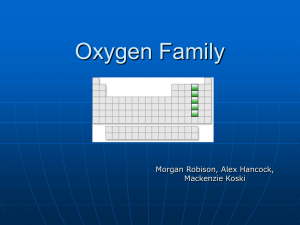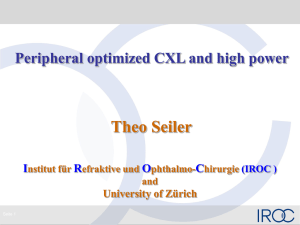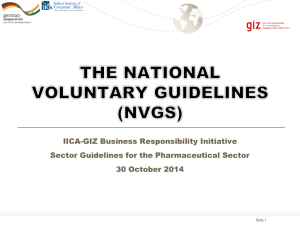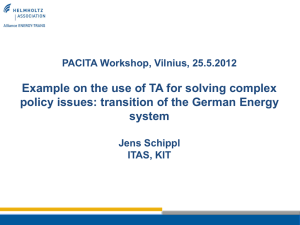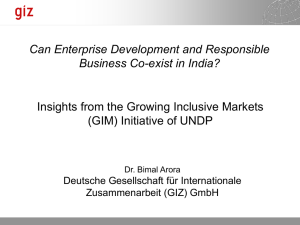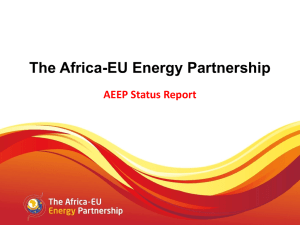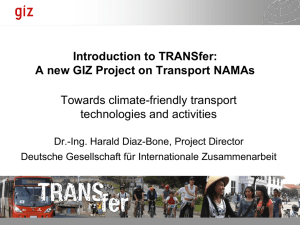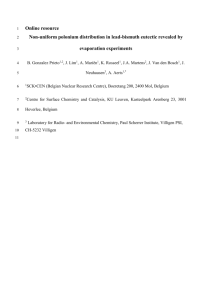Matthias RIZZI
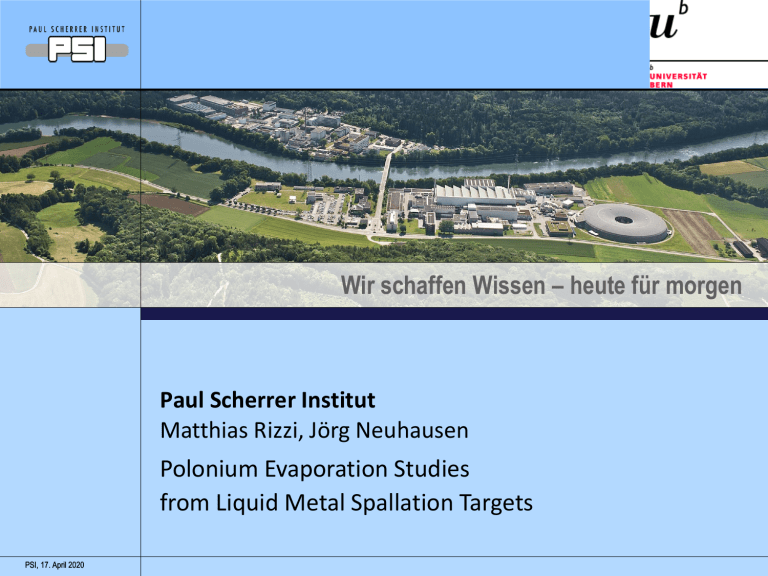
Wir schaffen Wissen – heute für morgen
Paul Scherrer Institut
Matthias Rizzi, Jörg Neuhausen
Polonium Evaporation Studies from Liquid Metal Spallation Targets
INDEX
• INTRODUCTION
• POLONIUM RELEASE
• EXPERIMENTAL TECHNIQUE transportation method - theory & experimental
• RESULTS & DISCUSSION
• SUMMARY & OUTLOOK
Matthias RIZZI Seite 2
INTRODUCTION
Radiological issues of spallation targets
• due to the high beam intensity and the large variety of nuclear interactions the target material becomes highly radioactive
• for a target material with a proton number N, every nuclide from 1 to N +1 can be formed
• production of highly radiotoxic polonium 210 due to neutron capture of bismuth
• lack of thermodynamical data for polonium
(vapor pressure, gaseous species)
Matthias RIZZI Seite 3
INTRODUCTION
210 Po is produced by neutron capture of 209 Bi and its following b decay
209
Bi
0
1 n
210
Bi
5 .
; 210
Po
210
Po
138 .
4 d 206
Pb
208
Pb
n
0 209
Pb
209
Pb
3 , b
209
Bi
Matthias RIZZI Seite 4
INTRODUCTION
Polonium-210
• biological half-life of 30-50 days
• high radiotoxicity in case of incorporation
(LD
50
2-15 MBq)
• is believed to form a volatile hydrogen species in presence of hydrogen and/or moisture
• for liquid spallation targets risk estimations and dispersion calculations in case of leakage are necessary for licensing
Matthias RIZZI Seite 5
POLONIUM RELEASE
Polonium
• the apparent vapor pressure of polonium is of main interest for thermodynamic calculations
• the volatile species of polonium and conditions for formation
• influence of cross effects like sputtering and aerosol formation
• stability and possible extraction/absorption of volatile species for filter design in nuclear facilities release experiments
Matthias RIZZI Seite 6
-2,000
-3,000
-4,000
-5,000
-6,000
-7,000
-8,000
-9,000
-10,000
-11,000
-12,000
2,00
POLONIUM RELEASE
Selected vapor pressure data for 210 Po
1,67 1,43 1,25 1,11 1,00 0,91
Normalized to
X
Po
=1*10 -6
400⁰C 600⁰C
Ohno, 2006
Abakumov, 1982
1000/T[K]
Buongiorno, 2003
Feuerstein, 1992
0,83
Abakumov [1982]: release experiments from lead, assumed γ
PbPo
=1, radiometric and direct vapor pressure measurement, T:368-745⁰C
Feuerstein [1992]: release experiments from Li
0.17
X
Po
T:350-700⁰C
Pb
0.83
,
=1.5*10 -13 , α-counting,
Buongiorno [2003]: release experiments from LBE,
X
Po
=2.5*10 -8 , Liquid
Scintillation Counting (LSC),
T:400-550⁰C
Ohno [2006]: release experiments from LBE,
X
Po
=2.2*10 -10 , LSC, T:450-750⁰C
Matthias RIZZI Seite 7
POLONIUM RELEASE
A dynamic method for vapor pressure measurements
• a solid or liquid sample gets heated in a constant stream of gas
• the gas phase gets saturated with the gaseous sample species
• quantification of the evaporated material
• calculation of the apparent vapor pressure vapor pressure function f(T)
• in case of pure substances, direct calculation of the saturation vapor pressure apparent vapor pressure functions in our case!
Matthias RIZZI Seite 8
POLONIUM RELEASE
N release
A
sat
P
Po
n
Po
R
T
V sat n
Po
N release
N
A
K
Henry
Po sat
P
Po
X
Po
A is measured at following energies: 286, 338, 522,
807 and 1032keV detector efficiency , specific g
-Intensity and a samplegeometry correction factor are included in
A
Matthias RIZZI Seite 9
EXPERIMENTAL TECHNIQUE
EXPERIMENTAL SETUP
•Closed system to prevent moisture and oxygen entering the rection tube
•Argon with 7% hydrogen in order to reduce the lead surface (PbO)
•Applied atmosphere gets directed through a drying cartridge and a getter furnace in order to remove moisture and oxygen
•quartz reaction tube
•sliding arrangement to apply temperature
Matthias RIZZI experimental setup scheme
Seite 10
EXPERIMENTAL TECHNIQUE
EXPERIMENTAL SETUP
•irradiated with
-particles
•lead-samples of ~0.7g mass
•sample on a quartz filter within a quartz boat
• 53 ml/min of 7%H
2 atmosphere applied
/Ar
•temperatures from 600⁰C up to
1100 ⁰C reaction-time 60min experimental setup scheme
Matthias RIZZI Seite 11
EXPERIMENTAL TECHNIQUE
PROCEDURE
•sample gets weighed and measured by g
-spectroscopy
(detection of 206 Po!)
•placement in a quartz-boat (with quartz filter) within the quartz heating gadget
•closing of the gadget, flush with atmosphere, heating of the furnace
•start of the experiment by sliding the furnace into the right postion
•stop after 60min, cooling down, g
-detection
Matthias RIZZI Seite 12
EXPERIMENTAL TECHNIQUE saturation of the gas phase with the sample species is crucial!
– Selection of the right atmosphere flux, sample and gadget geometry has to be considered
Matthias RIZZI variation of apparent vapor pressure with volumetric flow rate
(Viswanathan et al., J. Phys. Chem. B, Vol. 113, No. 24, 2009)
Seite 13
RESULTS & DISCUSSION
1,0
0,9
0,8
0,7
0,6
0,5
0,4
0,3
0,2
0,1
0,0
-0,1
500 relative release of Polonium from Pb
600 700 800 temperature [°C]
900 1000 f ( T )
5
0
0
-5
-10
-15
-20
Henry-constant for 206 Po evaporation from lead measured in the range 600 - 1100°C
0,5 1 1,5 2
1000/T [K]
2,5 3 with the given flux and reaction time calculation of the apparent vapor pressure
K
Henry
Po
P
Po
X sat
Po log K
Henry
Po
Pb
8 .
85
1 .
09
7352 .
6
1012
T
Matthias RIZZI Seite 14
3,5
RESULTS & DISCUSSION
1,0
0,9
0,8
0,7
0,6
0,5
0,4
0,3
0,2
0,1
0,0
-0,1
500 relative release of Polonium from Pb
600 700 800 temperature [°C]
900 1000
5 f ( T )
0
0
-5
Henry-constant for 206 Po evaporation from LGE measured in the range 675 - 900°C
0,5 1 1,5 2 2,5 3
-10
-15
-20
1000/T [K] systematically higher apparent vapor pressure for 206 Po over a LGE than compared to LBE or lead
3,5
K
Henry
Po sat
P
Po
X
Po
Matthias RIZZI log K
Henry
Po
LGE
8 .
74
1 .
05
5848 .
2
996
T
Seite 15
RESULTS & DISCUSSION
Evaporation Behavior of Pb, LBE and LGE
1.0
0.8
0.6
0.4
0.2
LBE (Neuhausen et al.)
Pb (this work)
LGE (this work)
0.0
600 700 800
Temperature [°C]
900 1000 evaporation of Po from lead is similar to that from LBE and LGE
Matthias RIZZI Seite 16
RESULTS & DISCUSSION
Henryconstants for Po from LBE/LGE/Pb
0
600
-2
-4
4
2
650 700 750 800 850 900
-6
Kurata LBE with H2
T [K]
Buong. LBE with H2
MR from Pb with Ar/H2 MR from PbAu Ar/H2
Matthias RIZZI
950 1000 1050 1100
JN Po from LBE Ar/H2
Seite 17
SUMMARY & OUTLOOK use of 206 Po instead of 210 Po the calculated saturation vapor pressures are
“apparent” vapor pressures – the composition of the gas phase is unknown (PbPo, H
2
Po,…) large errors due to experimental uncertainities fraction of polonium in the sample is not constant, continuous loss of signal saturation of the vapor is crucial!
Matthias RIZZI Seite 18
SUMMARY & OUTLOOK error reduction in our experimental technique proof of gas phase saturation
f(T,j) for given flux j at different temperatures influence of sample and gadget geometry performing experiments under an oxygencontrolled atmosphere (glove box) investigation of aerosol formation during transportation method experiments verification of the volatile polonium species (?) thermochromatographic studies of polonium
Matthias RIZZI Seite 19
THANKS TO
R. Eichler , D. Schumann, J. Neuhausen
S. Heinitz and S. L ü thi
THANK YOU FOR YOUR ATTENTION

